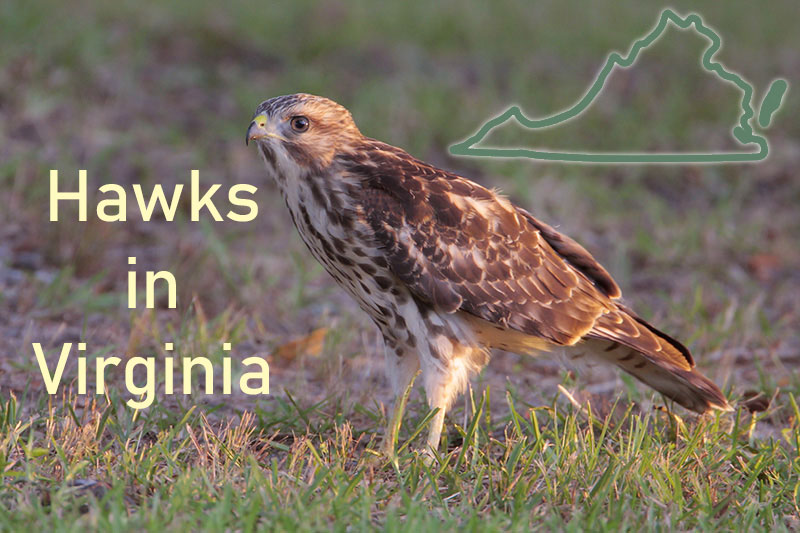
Virginia is a great place to see hawks! There are several hawks in Virginia, including Red-tailed Hawks that thrive in cities and Broad-winged Hawks that migrate all the way to Ecuador.
The hawks of Virginia hunt small animals in farm fields, woodlands, and other habitats throughout the state. Learn how to see and recognize these beautiful birds in this article!
On this page
Hawks That Live In Virginia
According to eBird data, in 2022-2023, there were 7 species of hawks in Virginia.
We’ll give you an overview of these birds to make identification easier!
Red-shouldered Hawk
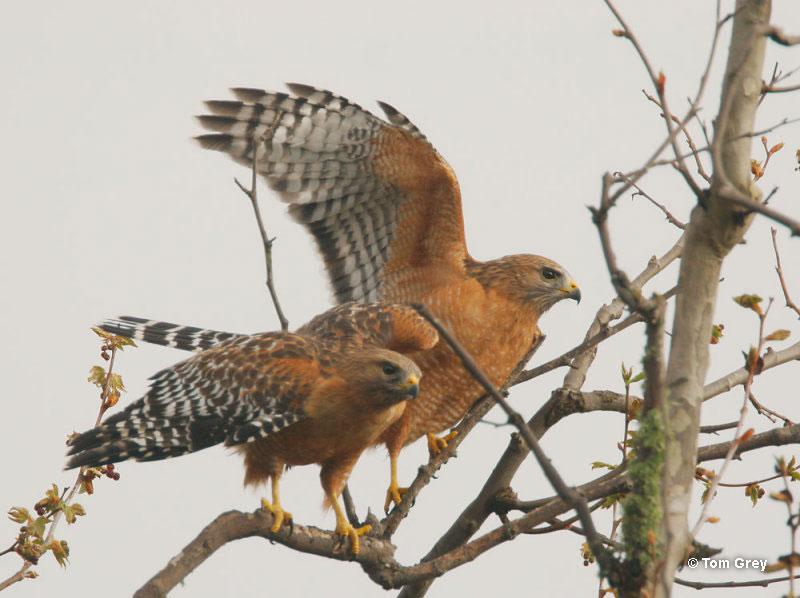
© Tom Grey
Scientific name: Buteo lineatus
Speed: 18-34 miles per hour
Length & Weight: 17 inches, 1.4 pounds
Wingspan: 40 inches
Call: “keer keer keer keer keer!”
The Red-shouldered Hawk is a medium-sized hawk with reddish-orange underparts and shoulder, and black and white on its wings and tail.
Both sexes are similar, but females are larger than males. Young birds are brown above and have dark streaks on pale underparts.
In flight, these hawks are best recognized by their longish, black and white tail and long wings with a pale crescent-shaped mark near the tip of the wing.
Red-shouldered Hawks prey on snakes, frogs, and other small animals. They forage by waiting on a perch and then swooping down to catch the animal on the ground.
This species builds a bulky stick nest high in a tree in wooded and semi-wooded areas, often near wetlands.
The Red-shouldered Hawk lives in a variety of woodland habitats in southeastern Canada, the eastern USA, California, southeastern Oregon, and Baja California, Mexico.
Key Identifications:
- Medium-sized, colorful hawk with reddish-orange underparts and shoulder, and black and white upperparts and tail.
- Forages for snakes and other small animals on the ground in woodland habitats.
- Builds a bulky stick nest high in a tree.
- Makes loud, jay-like, ringing calls, “keer keer keer keer keer!”
The Red-shouldered Hawk is a medium-sized hawk with reddish underparts and shoulder, and a black and white tail. This raptor lives in a variety of wooded areas and even wooded neighborhoods in California and Florida. This species can join American Crows to harass and chase away Great-horned Owls.
Red-tailed Hawk
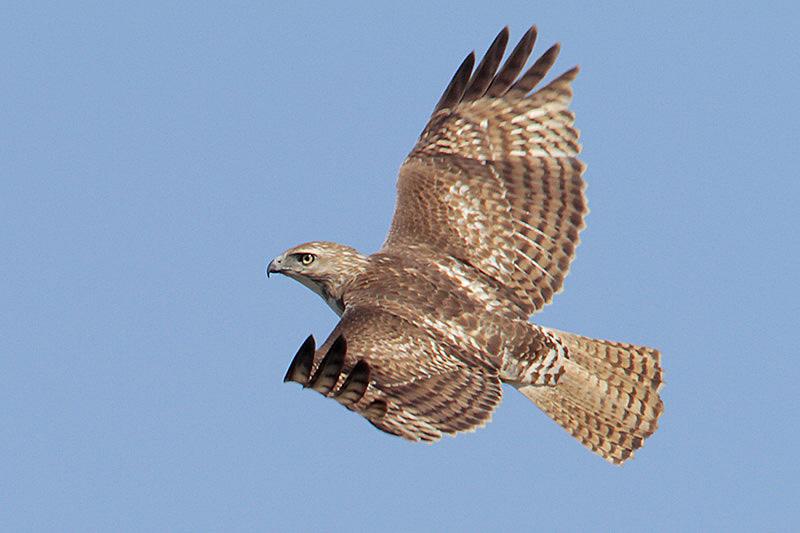
Red-Tailed hawk (Juvenile) © Greg Lavaty.
Scientific name: Buteo jamaicensis
Speed: 20-40 miles per hour
Length & Weight: 19 inches, 2.4 pounds
Wingspan: 49 inches
Call: “keeeyah!”
The Red-tailed Hawk is a big and bulky hawk with dark brown upperparts and long, broad wings. Adults have a broad reddish tail and both sexes are similar (although females are larger than males).
In the east, adults have pale underparts with dark marks on their belly, but western birds can be dark brown, buff, or reddish-brown below. Young birds have brown tails with dark barring.
In flight, all Red-tailed Hawks show a large, somewhat square-shaped, pale area near the tips of their wings.
See more: Owls in Virginia
This species preys on a variety of small animals, including squirrels, rats, snakes, and birds. It catches prey by swooping down from a perch or from soaring flight.
Red-tailed Hawks build a messy stick nest high in a tree or on the ledge of a building.
They use a wide range of habitats in Alaska and the USA, much of Canada, Mexico, the Caribbean, and parts of Central America.
Key Identifications:
- Large, hefty hawk with a reddish tail and dark marks on its pale belly.
- Preys on small mammals, snakes, and birds.
- Builds a bulky stick nest high in a tree.
- Makes loud, jay-like, ringing calls, “keeeyah!”.
The Red-tailed Hawk is a hefty hawk with long broad wings, a broad reddish tail, and dark marks on its pale belly. In most places, this is the big hawk seen perched next to and soaring over roads and fields. The “raptor scream” often heard in movies and television shows is the call of the Red-tailed Hawk.
Cooper’s Hawk
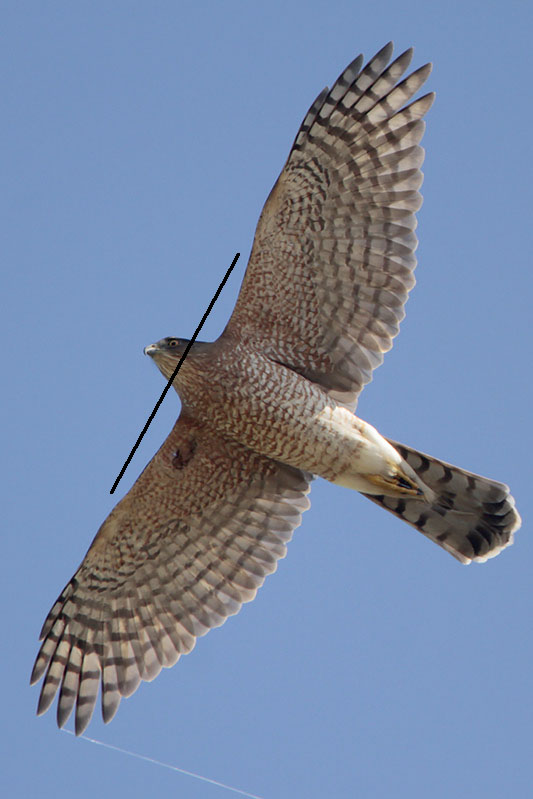
Scientific name: Accipiter cooperii
Speed: 21-55 miles per hour
Length & Weight: 16.5 inches, 1 pound
Wingspan: 31 inches
Call: “kek kek kek kek kek!”
The Cooper’s Hawk is a fair-sized hawk with a long, rounded tail and a blocky, square-shaped head. Adults are blue-gray above and have orange barring below.
Both sexes look similar, although females are larger. They also often show a dark cap, have pale grayish on their face and side of the neck, and dark banding on their tail.
Young birds are shaped like adults but are dark brown above, have paler brown on the head, and fine dark streaking on pale underparts.
In flight, this species uses its rounded wings to make a few deep flaps followed by a brief glide.
The Cooper’s Hawk preys on doves and other medium-sized birds and small mammals. It usually catches them on the ground and frequently attacks birds at feeders.
This species lives in a variety of wooded and semi-wooded habitats in southern Canada, most of the USA, and in parts of Mexico.
Key Identifications:
- Fair-sized hawk with orange barring below, blue-gray above, and a long rounded tail.
- Preys on small mammals and starlings and dove-sized birds in woodlands, parks, and towns.
- Builds a bulky stick nest high in a tree.
- Usually quiet, but when breeding, it makes a loud barking call, “kek kek kek kek kek!”
The Cooper’s Hawk is a fair-sized hawk with a long, rounded tail. In many areas, it has become adapted to people and catches birds and small mammals in woodlands and towns. The pesticide DDT caused large declines in Cooper’s Hawk populations in the 1950s and 60s but, since then, this species has regained its numbers and become a common bird.
Northern Harrier
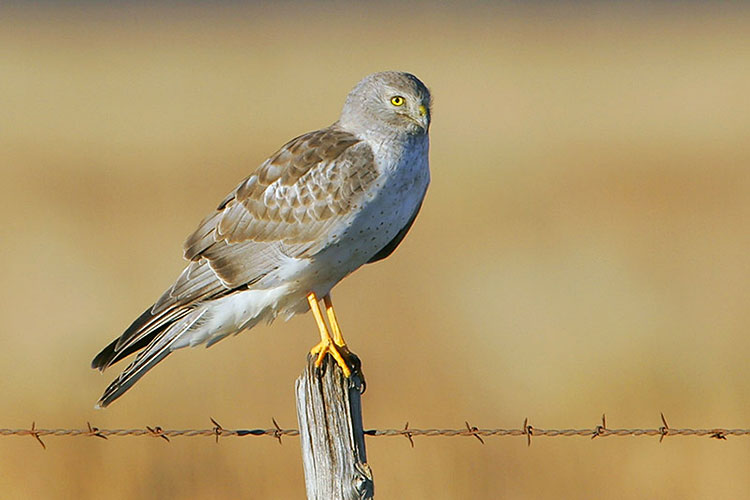
Scientific name: Circus hudsonius
Speed: 21-38 miles per hour
Length & Weight: 18 inches, 15 ounces
Wingspan: 43 inches
Call: “che che che che che che”
The Northern Harrier is a fair-sized, unique hawk with long wings, a long tail, and a white rump. Adult males have gray upperparts, head, and breast. They also have some pale brown spotting on their underparts and black tips on their wings.
Females are dark brown above and have dark brown streaks on pale underparts. Young birds are dark brown above but have deep orange-buff underparts.
All Northern Harriers have a white rump and glide low over the ground on long wings held in a “V” shape.
This species preys on small animals caught on the ground, sometimes after hovering.
It uses grass and other vegetation to make a shallow, platform nest on the ground, in thick wetland or grassland areas.
Northern Harriers breed in grasslands and other open habitats in Alaska, Canada, California, and the northern and central USA. They winter in much of the USA, Mexico, and rarely to northern South America.
Key Identifications:
- Distinctive long-winged, long-tailed hawk with a white rump.
- Glides low over the ground to catch rodents and other small animals in marshes and other open grassy habitats.
- Builds a platform nest on the ground, in tall thick grass.
- Makes a repetitive, woodpecker-like call, “che che che che che che”
Northern Harriers are long-tailed, long-winged hawks with white rumps. They glide low over the ground of grasslands and marshes to hunt for small animals. This bird and the Hen Harrier of northern Eurasia used to be considered the same species but despite their similar appearance, studies have shown that the Northern Harrier is a distinct species.
Sharp-shinned Hawk
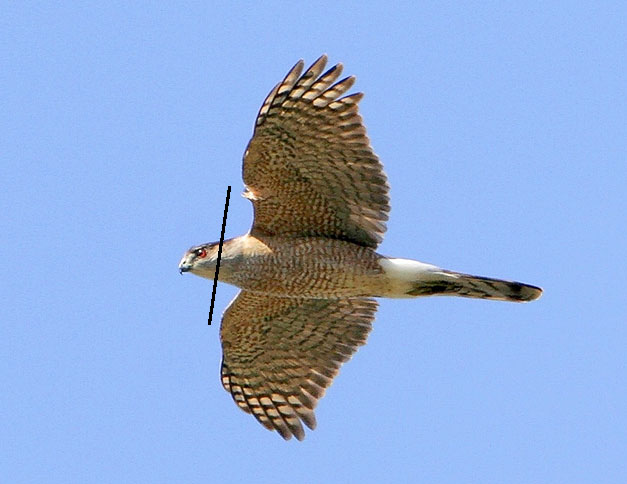
Scientific name: Accipiter striatus
Speed: 16-60 miles per hour
Length & Weight: 11 inches, 5 ounces
Wingspan: 23 inches
Call: “kew kew kew kew kew kew kew kew”
The Sharp-shinned Hawk is a small hawk with a long, rectangular tail and rounded wings. Adults have blue-gray upperparts, orange barring on their underparts, and dark bands on their tail.
Females are larger than males and young birds are dark brown above with thick brown streaks on pale underparts.
This species flies with several quick wing beats followed by brief glides. When flying, its head doesn’t stick out as much as a Cooper’s Hawk and it shows a square-tipped tail.
The Sharp-shinned Hawk preys on small birds up to the size of an American Robin. It mostly catches birds around the same size as sparrows, warblers, and vireos by quickly flying and catching them in vegetation.
This hawk builds a bulky stick nest high in a conifer.
Sharp-shinned Hawks live in wooded habitats in Alaska, much of Canada and the USA, Mexico, parts of Central America, the Caribbean, and parts of South America.
Key Identifications:
- Small hawk with rounded wings and a long, rectangular tail.
- Preys on small birds in woodland habitats.
- Builds bulky stick nest high in a conifer.
- Usually quiet but on breeding grounds makes falcon-like, repeated ringing calls “kew kew kew kew kew kew kew kew”.
This small hawk with a long, rectangular tail breeds in coniferous forests and winters in a range of wooded habitats. It often attacks small birds at feeders. The Sharp-shinned Hawk gets its name from its thin legs that have angled, “sharp” shins.
Broad-winged Hawk
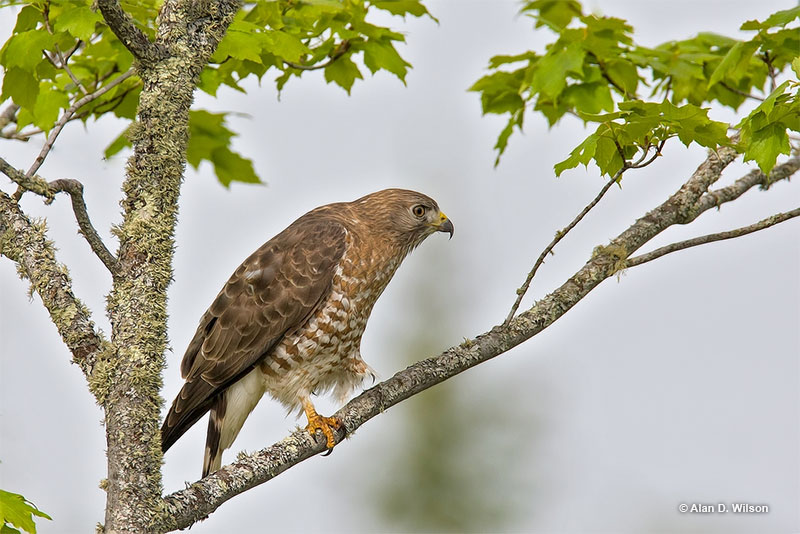
Scientific name: Buteo platypterus
Speed: 20-40 miles per hour
Length & Weight: 15 inches, 14 ounces
Wingspan: 34 inches
Call: “sipeeeeeeeee”
The Broad-winged Hawk is a smallish raptor around the same size as a crow. Adults are dark brown above, have dark, reddish-brown barring below, and a broad tail with a few wide, white bands.
Both sexes look the same and also have a thick dark mark on each side of their throat although females are larger. Young birds have dark brown streaks on pale underparts.
In flight, this species often soar, showing a broad black and white tail, and long wings shaped like a “paring knife” that have a dark trailing edge.
This raptor preys on voles, frogs, insects, and other small animals. These hawks catch food by waiting on a perch and then quickly swooping down to the ground.
Broad-winged Hawks make a bulky stick nest high in a tree.
This small hawk breeds in forest habitats in central and southeastern Canada and much of the eastern USA. It winters in southern Florida and Mexico south to Bolivia.
Key Identifications:
- Chunky, smallish, crow-sized hawk with a few white bands on its tail and underparts with brown barring or streaks.
- Preys on insects and small animals in woodland habitats.
- Builds a bulky nest high in a tree.
- Makes a high-pitched call, “sipeeeeeeeee”
This chunky, crow-sized hawk has a few prominent white bands on its broad tail and either dark barring below or dark streaks. It often soars above and near woodland habitats. In southern Texas and some other places, thousands of Broad-winged Hawks can be seen as they migrate between breeding and tropical wintering grounds.
Rough-legged Hawk
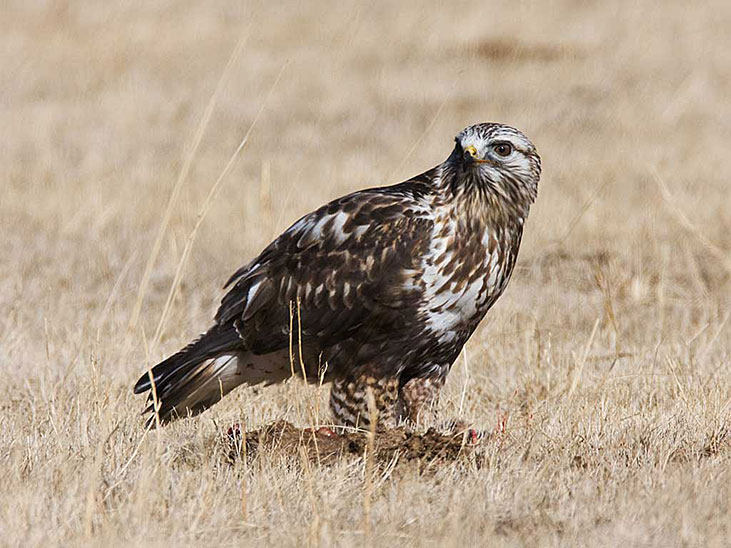
Scientific name: Buteo lagopus
Speed: 22-28 miles per hour
Length & Weight: 22 inches, 1.3 to 3.6 pounds
Wingspan: 53 inches
Call: “reeaaaauh!”
The Rough-legged Hawk is a long-winged hawk with a black and white tail. There are two color morphs; both with broad white patches near dark wing tips, and a longish pale tail with a broad black tip.
Pale females and juveniles are pale gray-brown with a black belly and black “wrists” in their wings. Pale adult males are more cold gray, have less black on their belly, and heavily streaked breasts.
Dark females and juveniles are dark brown except for their tail and flight feathers. Dark adult males are black except for their flight feathers and tail.
In flight, this species holds its wings in a shallow “V”.
Rough-legged Hawks soar and hover over open fields where they prey on voles and other small animals.
It builds a bulky nest on a cliff or rocky outcropping.
The Rough-legged Hawk breeds in tundra in Alaska, northern Canada, and northern Eurasia, and winters in open fields in southern Canada, the northern, central, and western USA, and Europe and Asia.
Key Identifications:
- Big hawk with a longish black and white tail, and long wings with broad white patches near the dark wing tips.
- Preys on rodents and other small animals in wide open habitats.
- Builds a big, bulky nest on cliffs and rocky outcroppings in tundra.
- Makes a loud, clear descending call, “reeaaaauh!”.
The Rough-legged Hawk is a big, long-winged hawk with a black and white tail, and broad white patches near the tips of their wings. They hover and soar over weedy fields and other open habitats to hunt for rodents and birds. This species is one of the only hawks in North America that has feathers on its legs.
Hawks of Virginia – Frequently Asked Questions
Are hawks rare in Virginia?
No, many hawks are common in Virginia.
Are hawks protected in Virginia?
All hawks in Virginia are protected by state laws and the Federal Migratory Bird Treaty Act.
Are there gray hawks in Virginia?
The species known as “Gray Hawk” does not live in Virginia. However, other hawks with gray plumage do live in the state. Adult Cooper’s Hawks and Sharp-shinned Hawks both have slate-gray on their upperparts. The adult male Northern Harrier is also mostly plumaged in gray.
Are there falcons in Virginia?
Yes, six species of falcons are on the official Virginia bird list.
What is the most common hawk in Virginia?
The most common hawk in Virginia is the Red-shouldered Hawk. According to eBird, this species is seen more often than any other hawk in the state.

